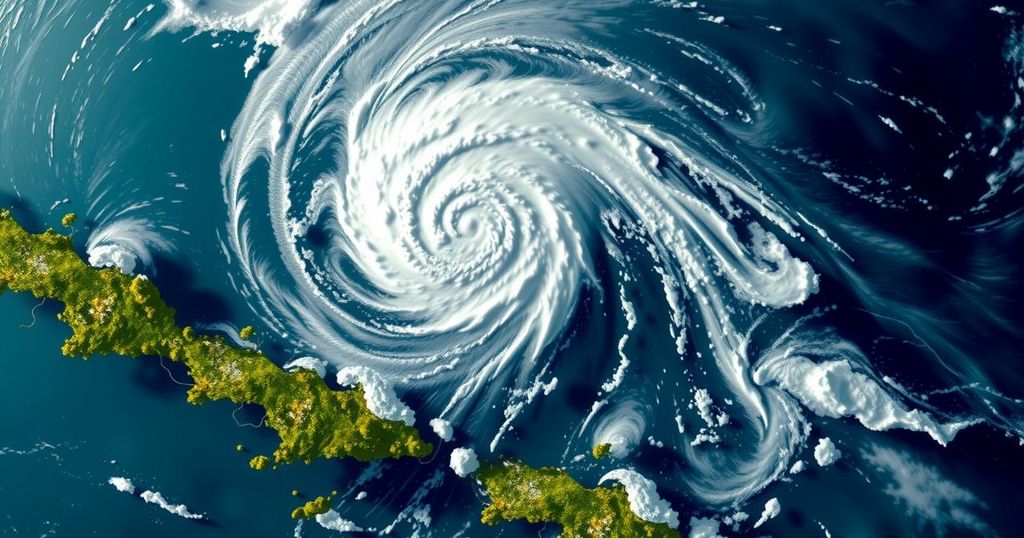Tropical Storm Oscar Advances Toward the Bahamas After Impacting Cuba as a Hurricane

Tropical Storm Oscar moved toward the Bahamas after making landfall in Cuba as a Category 1 hurricane, causing six deaths and heavy rainfall. It is notable for being the smallest recorded hurricane. Up to 15 inches of rain fell in eastern Cuba, amid struggles with a power outage. The National Oceanic and Atmospheric Administration predicts an active hurricane season for 2023. Concurrently, Tropical Storm Kristy is expected to gain strength in the Pacific Ocean.
Tropical Storm Oscar progressed toward the Bahamas on Tuesday after making landfall in Cuba as a Category 1 hurricane. The storm has resulted in at least six fatalities while unleashing heavy rainfall across regions already affected by a significant power outage. At the time of reporting, Oscar was situated approximately 45 miles (75 kilometers) south-southeast of Long Island in the Bahamas, with sustained winds of 40 mph (65 kph) and a north-northeast movement speed of 12 mph (19 kph), as reported by the National Hurricane Center in Miami. “Oscar is at best barely a tropical storm at this time,” stated the center. Rainfall projections for the southeastern Bahamas range from 5 inches (13 centimeters) to 8 inches (20 centimeters) in certain locales, leading to the issuance of a tropical storm warning for parts of the central and southeastern Bahamas. Historically, Oscar is noted for being the smallest hurricane on record, with a wind field measuring only about 6 miles (10 kilometers) in diameter. Its landfalls, first on Grand Inagua Island in the Bahamas and subsequently on eastern Cuba, were characterized by a lack of forecast accuracy, surprising meteorologists who noted a lack of predictive models indicating potential hurricane strength. Michael Lowry, a hurricane specialist, commented, “It’s not often we see a colossal failure in hurricane forecasting.” Following its landfall, Oscar produced upwards of 15 inches (38 centimeters) of rainfall in eastern Cuba, prompting warnings of significant flooding and possible landslides. The fatalities occurred in Guantánamo. The storm struck amid Cuba’s ongoing recovery from a massive blackout, which has incited public demonstrations, leading to stern government warnings against unrest. Oscar represents the 15th named storm and the 10th hurricane in the Atlantic hurricane season, which spans from June 1 to November 30. The National Oceanic and Atmospheric Administration has forecasted an above-average hurricane season for 2023 due to record-warm ocean temperatures, predicting between 17 to 25 named storms, including four to seven major hurricanes of Category 3 or higher. Concurrently, Tropical Storm Kristy was noted swirling over open Pacific waters, located 375 miles (605 kilometers) west-southwest of Acapulco, Mexico, with projected strengthening into a hurricane by Tuesday evening.
Tropical Storm Oscar’s emergence as both a hurricane and significant storm event underscores the challenges encountered in meteorological forecasting. The Atlantic hurricane season typically runs from June to November and has been characterized in recent years by increased storm activity, partially attributed to rising ocean temperatures. The implications of hurricanes are far-reaching, impacting not only infrastructure and safety but also the economic and social stability of affected regions, such as Cuba, which has been grappling with a power crisis. The unusual characteristics of Oscar, including its size and unexpected strength, highlight the ongoing difficulties faced by forecasters and emergency management services in preparing for storm impacts, particularly in vulnerable areas.
In conclusion, Tropical Storm Oscar has proven to be a deadly and unexpected storm, marking a significant event in the 2023 Atlantic hurricane season. With at least six lives lost and notable rainfall causing flooding in Cuba, the storm raises serious concerns regarding forecasting accuracy and the preparedness of regions impacted by tropical storms. As meteorological models continue to evolve, the unpredictability of these weather patterns remains a critical focus for researchers and emergency response teams alike. Meanwhile, Tropical Storm Kristy poses another threat as it gains strength in the Pacific, indicating a continuing trend of active storm systems this season.
Original Source: www.seattletimes.com








